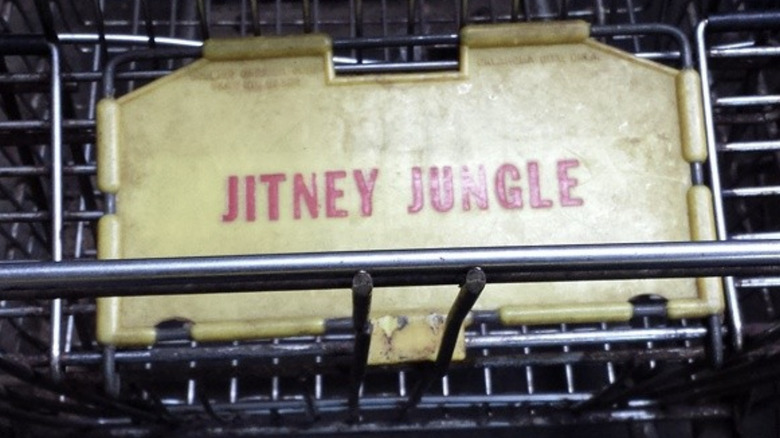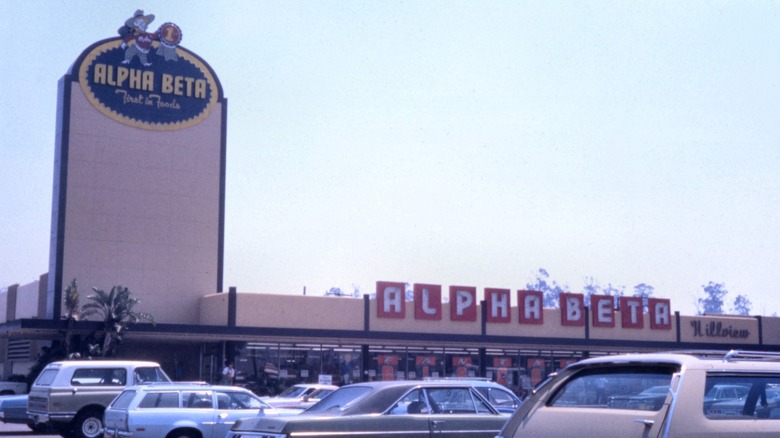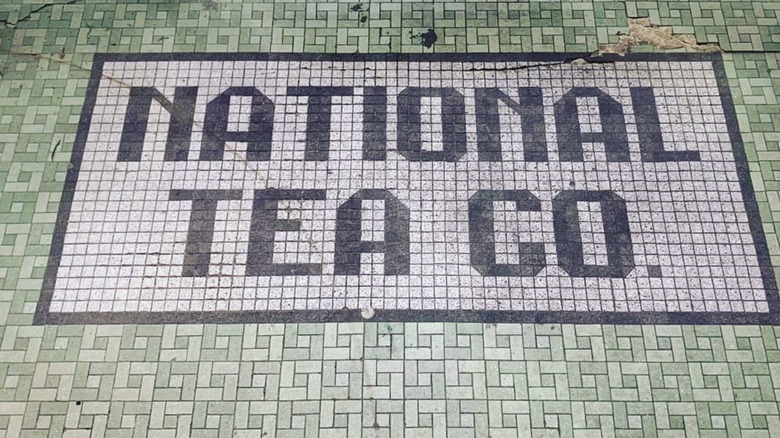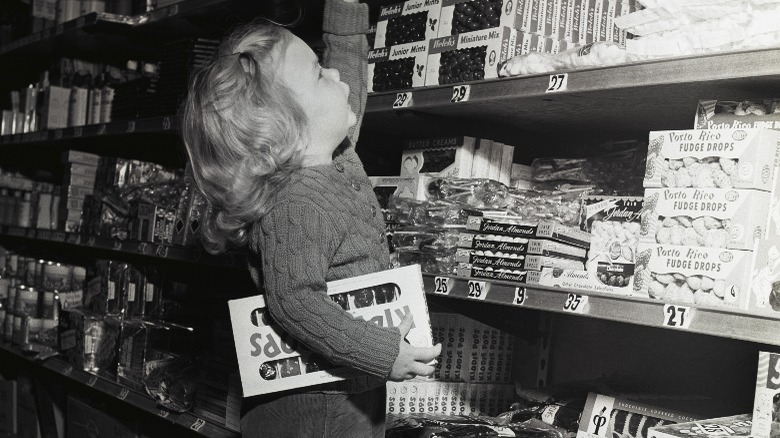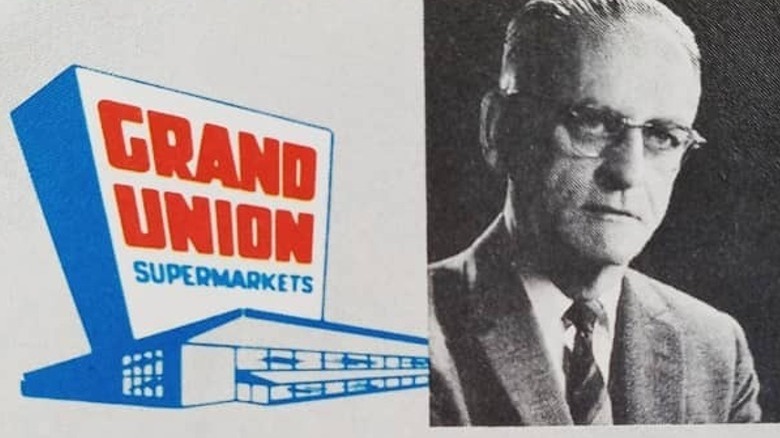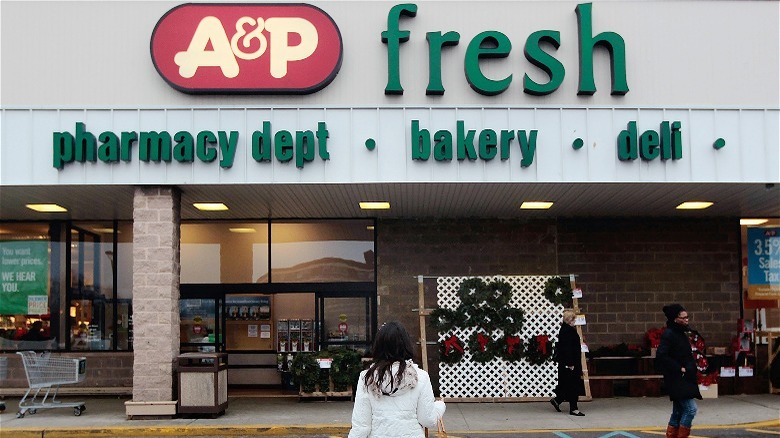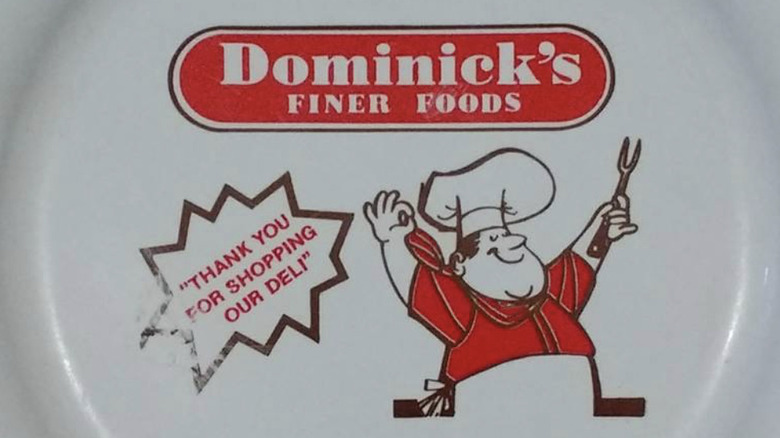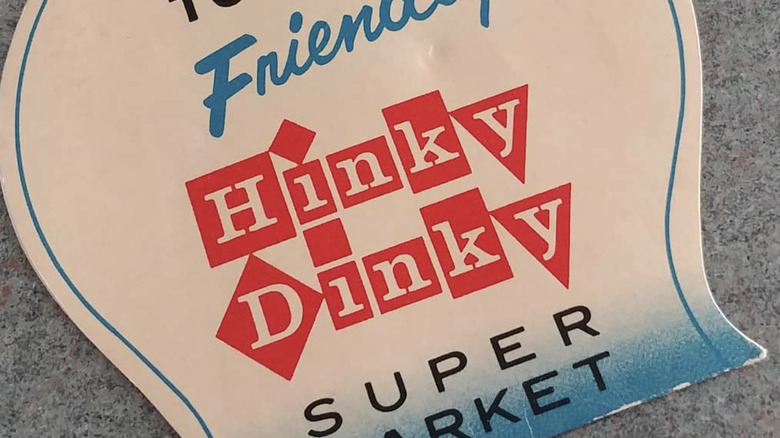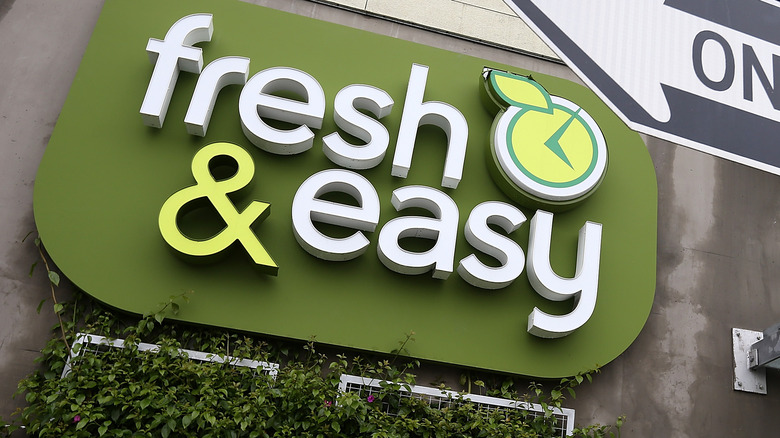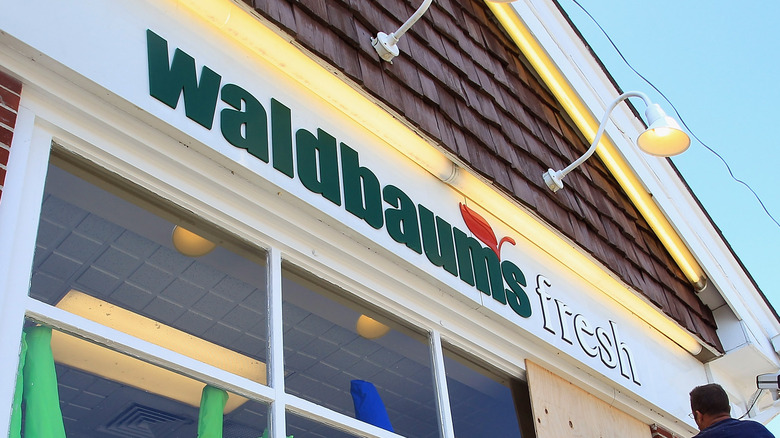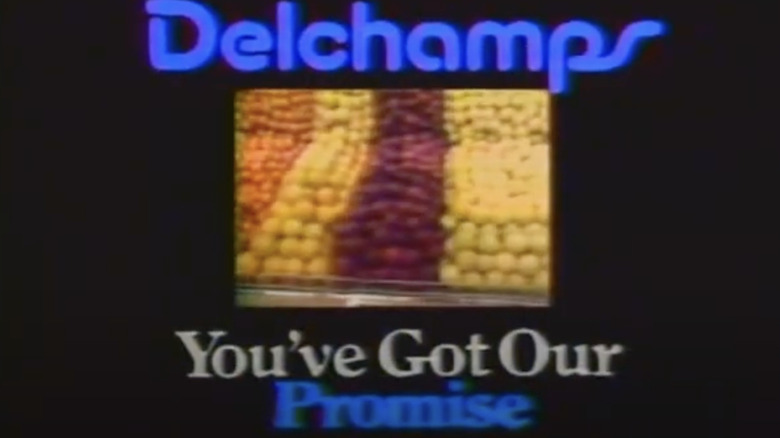12 Grocery Stores That No Longer Exist
It's easy to take grocery stores for granted. They've been part of American daily life for more than a century. Most people currently live within a few minutes of a supermarket — no matter if it's independent, part of a beloved regional chain, or one outlet out of thousands — where all of their food needs can be met. Even smaller stores can provide popular grocery items such as produce, meat, dairy, canned goods, and bakery products.
Everyone needs food. On a corporate and commercial level, that makes supermarkets a cutthroat industry, made all the more challenging by razor-thin profit margins. Labor costs, as well as fluctuations driven by quickly changing food trends, mean that the grocery store industry is always in flux. As a result, stores that were once considered institutions can simply vanish from our neighborhoods. Some of the most reliable stalwarts of the past aren't around anymore. Here are 12 grocery stores that no longer exist.
1. Jitney-Jungle
Three local families started the first Jitney-Jungle grocery store in Mississippi, in 1919. The company never dropped or altered its alliterative name, built on 1910s slang. "Jitney" was a word for a nickel, a reference that reflected the affordability of the store. "Jungle" referred to the gathering of unspent nickels that would "jingle" in happy customers' pockets.
Jitney-Jungle would grow into a chain dominant in the South, comprising around 200 grocery stores, convenience stores, and a couple of liquor stores. These businesses were spread across states like Mississippi, Alabama, Arkansas, Tennessee, Florida, and Louisiana. But the chain's success did not last forever.
In 1996, Jitney-Jungle was bought by a New York investment firm for around $400 million. Shortly after, a Jitney-Jungle chairman of 31 years retired. The decline continued. In 2000, most locations were purchased by rival Southern grocery store chain Winn-Dixie. The Jitney-Jungle stores were then converted into Winn-Dixie locations. Today, the now-defunct chain doesn't have any stores left.
2. Alpha Beta
In 1900, Canadian brothers Albert and Hugh Gerrard opened a butcher shop in Pomona, California. They expanded their business by opening a small grocery store in 1914. When things got busy, they let customers shop for themselves. At the time, it was customary for a clerk to assist every shopper, personally selecting all of the items they wished to buy. The clientele enjoyed this new method of helping themselves. Also, the reduced labor costs afforded by this style may have helped keep prices low. We're betting the customers liked this, too.
In 1915, the Gerrard brothers opened a larger, self-service market called the Triangle Groceteria. However, some customers weren't familiar with the new shopping style yet. To help people more easily locate items, the store was arranged in alphabetical order. The gimmick worked so well that the Gerrard brothers opened more outlets with the same format. They named the larger company Alpha Beta, after its alphabetical system. During the peak of its popularity, Alpha Beta had more than 250 stores.
In 1961, Alpha Beta merged with a company called American stores. Years later, American stores would purchase another chain called Lucky Stores. After this merger, Alpha Beta stores began to disappear, until all locations were gone for good.
[Image by Werner Weiss via Wikimedia Commons | Cropped and scaled | CC BY 2.0]
3. National Supermarkets
This defunct supermarket chain goes by many names. You may remember it as National Supermarkets, or simply National. But the story of this former chain begins with a business called the National Tea Company. In 1899, the National Tea Company opened its first location in Chicago. Within 30 years, National Tea had more than 1,600 full-service grocery stores in the United States, with more than 600 in the Chicago area alone.
But then the Great Depression hit, and National Tea suffered. The company closed down many locations but stayed afloat until the economic situation improved. After this period, it grew by acquiring smaller, regional chains. During a popularity peak in the 1950s, the Canadian grocery company George Weston Ltd. bought National Tea and shortened the grocery store chain's name. Following this, the company was involved in a series of financial struggles, including a bankruptcy filing in 1999. Today, you won't see any locations of this grocery chain.
4. Weingarten's
The former grocery chain Weingarten's was spearheaded by a man named Joseph Weingarten. He was born in Poland but moved to the U.S. as a child. His entry into the supermarket world began around 1901 when Joseph and his father opened a grocery store in Houston, Texas.
The pair opened a second grocery store in 1920, which gained popularity using somewhat novel concepts for the time, like self-service shopping. The number of Weingarten's stores in the U.S. continued to expand throughout Joseph's lifetime. By the time of his death, Weingarten's had 70 locations.
By 1980, the Weingarten company was sold to a business called Grand Union. Following this, Grand Union began to resell old former Weingarten grocery stores to competitor grocery chains such as Randall's and Safeway, which used the locations to open more of their own stores. That's why, unfortunately, you don't see Weingarten's grocery stores anymore.
5. Food Fair and Pantry Pride
The story of the chain Food Fair begins in Harrisburg, Pennsylvania. Food Fair founder Samuel Friedland got things started when he opened a store called the Reading Giant Quality Price Cutter in the 1920s.
After a few decades in the grocery business, Friedland changed the company's name to Food Fair. In 1958, Food Fair purchased Setzer's, a fellow grocery store chain with 40 units to its name at the time. Food Fair made even more big moves. In 1961, the company purchased a line of department stores called J.M. Fields. It also bought a Philadelphia-area chain called Best Markets, which owned a popular brand called Pantry Pride. That name proved so successful that Food Fair converted the majority of its outlets into Pantry Pride locations.
In 1978, the company filed for bankruptcy protection. Food Fair survived this financial hurdle but struggled in the years to come. Its grocery stores started to disappear. The last Food Fair and Pantry Prides stores were gone by 2000.
6. Grand Union
The grocery store Grand Union sprung out of a Pennsylvania-based business called the Jones Brothers Tea Company, which was founded in 1872. Even at their first store, there was more than just tea for sale. The store sold grocery items like coffee, flavoring extracts, and spices.
After opening this first shop, the brand began to expand. The Jones Brothers Tea Company grew to operate subsidiary chains — one of which went by the name Grand Union. During a peak, there were more than 500 stores owned by the group. There were locations in several states, including New York, New Jersey, Pennsylvania, Connecticut, and Vermont.
The company held on for a long time. It was still around to declare bankruptcy as recently as the 1990s. By this time, the company had been going by the name Grand Union. After filing for bankruptcy several times, a deal was struck to distribute some Grand Union locations to new owners. Grand Union's stores disappeared for many years. But in 2022, the chain was relaunched. Once again, there are several Grand Union stores in the Northeast.
7. A&P
The name A&P is short for the Great Atlantic & Pacific Tea Company. This title is a reference to the Transcontinental Railroad, which was the talk of the town during the early days of A&P. That should give you an idea of how old this grocery chain is.
A&P began in 1859, as a single facility. By the turn of the century, A&P would comprise around 200 stores. It differentiated itself from other rising chains of the era by pioneering the use of premiums. Through this concept, frequent shoppers could use coupons to buy special items like glassware. It also played a leading role in the history of supermarket meat. By establishing a national meat department, it helped this section become a grocery store staple. A&P's success helped it to grow to the biggest supermarket chain in the country, with more than 15,000 stores. But this did not last.
By 2012, that store count had dwindled to 320. A&P filed for bankruptcy in 2015. By 2018, all of the company's stores had been closed and their locations sold.
8. Dominick's Finer Foods
Dominick's Finer Foods was a Chicago-area institution. It opened in 1918, inside a 1,000-square-foot space on the Northwest side of the city. Founder Dominick DiMatteo hand-selected the store's products from local markets daily, before selling them in his store. As the store grew in popularity, so did its size. A larger, 14,000-square-foot shop opened in a new location, replacing the original one.
The chain stuck around for several decades, during which it helped to pioneer the idea of a one-stop shop. At Dominick's, you could find everything you needed in one place. This included offering video rental counters and photo development centers within stores.
With 18 locations to its name, Dominick's Finer Foods was sold to a brand called Fisher Foods in 1968. In turn, Fisher Foods helped the chain grow to around 70 locations. At this point, the founding DiMatteo family repurchased Dominick's Finer Foods. However, the chain was plagued by legal issues in the years to come. It would be sold again, eventually landing in the hands of grocery competitor Safeway. In 2013, Safeway began selling off the remaining locations of Dominick's and announced plans to close any locations that weren't sold by the following year.
9. Hinky Dinky
The supermarket chain Hinky Dinky was founded in Omaha, Nebraska in 1925. Its silly-sounding name makes sense when you have some historical context to go with it. Hinky Dinky competed for business with the similarly-named supermarket company Piggly Wiggly, then a pioneer in the grocery store industry.
To stand out, Hinky Dinky implemented innovations such as automated doors and checkout counters (both of which were more impressive at the time). The company even placed ATM-like machines inside some of its stores, allowing customers to quickly get cash.
The slow and eventual demise of Hinky Dinky began after 1972. That year, it was acquired by another company called Cullum. Following the acquisition, Hinky Dinky's success began to decline. By the 1980s, the remaining Hinky Dinky stores seemed like more trouble than they were worth to parent company Cullum. In 1985, Cullum sold the remaining locations of Hinky Dinky. The stores changed hands again in 2000 but didn't stick around for much longer after that. Today, there are none left.
10. Fresh & Easy
Tesco is among the four biggest supermarket companies in the United Kingdom. At one point, the company's success was so great that Tesco was considered the third-largest food retailer in the world. Since it was doing so well, the grocery store chain decided to try entering the crowded American supermarket realm by launching a chain called Fresh & Easy. It started by opening a few stores on the West Coast in 2007. By 2008, Tesco had opened 60 Fresh & Easy stores in the U.S.
By early 2013, things were not going so well. Even though there were now around 200 locations, Tesco had already lost billions of dollars during these early days of the Fresh & Easy chain. One major misstep occurred when Tesco spent millions building a distribution center in Southern California. Even this new center couldn't slow Fresh & Easy's decline. In an attempt to turn things around, Tesco closed 50 stores and announced plans for an e-commerce venture. This didn't help either. In 2015, Fresh & Easy filed for bankruptcy. At that point, Tesco decided it was time to leave its American chain behind.
11. Waldbaum's
When Ira Waldbaum took control of the grocery chain that bore his family name in 1948, his father had built it into a modest collection of six neighborhood food stores in Brooklyn. Waldbaum then took the small supermarket chain on a tear, expanding into nearby New York City suburbs — especially places like Westchester County and Long Island — which were exploding in growth. The Waldbaum's chain grew even further through the acquisition of New England stores in 1970. After this point, it rapidly built new locations as well.
By 1986, Waldbaum's controlled a healthy 140 stores. All of them were located in just three states: Massachusetts, Connecticut, and New York. At this point, the larger American grocery chain A&P purchased Waldbaum's for $287 million. Although owned by A&P, some Waldbaum's stores maintained their original name and stayed open until 2015. That's when A&P filed for bankruptcy and sold off all of its assets, including Waldbaum's.
12. Delchamps
The very first Delchamps grocery store opened for business in Mobile, Alabama, during the 1920s. It was started by brothers Alfred and Ollie Delchamps. The business quickly got the locals' attention with its self-service format. By 1929, there were six Delchamps grocery stores around Mobile. By the end of the century, Delchamps would operate more than 100 stores in the South. The business was so important to the city of Mobile that it even made the original Delchamps store an official historical site in 1996.
In July 1997, Delchamps was ready for a change. It agreed to be acquired by fellow Southeastern grocery giant Jitney-Jungle for $213 million. The year prior, an investment firm had purchased Jitney-Jungle for $400 million. But even this shift didn't last long. Jitney-Jungle filed for bankruptcy in 1999. In doing so, it closed 45 of 200 stores under both the Delchamps and Jitney-Jungle names. By 2000, Jitney-Jungle was down to around 100 stores. It was then sold to another Southern grocery player, Winn-Dixie, for $85 million.

